| |
|
|
Send This E-newsletter to
Everyone You Know
The Cathy Harris
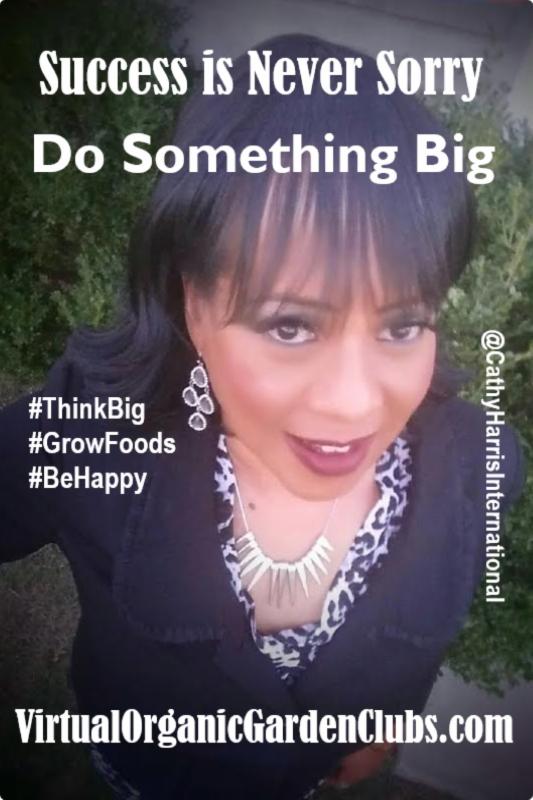
Empowerment and Motivational Speaker,
Non-GMO Health and Wellness Expert, Advice Columnist at
DearCathy.com, Self-Publishing and Business Coach at
Press Release
For Immediate Release
Aug. 10, 2017
CONTACT:
Angels Press
Attn: Cathy Harris, CEO and President
P.O. Box 19282
Austin, TX 78760
(512) 909-7365
The Cathy Harris Tour Brings
GMO Food Fight
To Several Cities
Cathy Harris, an Austin, TX business owner, Non-Genetically Modified Organism (GMO) Food Expert, and author of 24 non-fiction books including 5 books on health and 2 business books will be taking the Non-GMO food fight to several cities. The tour motto is
"Save As Many As You Can."
Cathy's latest movement,
"Virtual Organic Garden Clubs" has 3 phases
Phase I,
Phase II,
Phase III and was launched by
"The Essential Women's Movement for African American Women." Her latest book release
Foods can have a profound effect on your behavior, mood, happiness, and your entire quality of life. As a Non-GMO Health and Wellness Expert, Cathy is centered around informing the public as to how they can use natural methods to revolutionize their health, while avoiding Genetically Modified Organisms (GMOs).
As a Speaker, Author and Coach, she will be providing basic self-sufficiency and survival skills to communities, while helping everyone gain access to health and business opportunities around growing their own foods and will provide empowerment seminars and workshops on health/GMOs/mandatory vaccinations, business ideas for youth and adults, self-publishing, police interactions 101, and credit repair (click here).
Upcoming 2017 Schedule for Cathy Harris:
- Spiro, OK, Aug. 19, 2017
- Fort Smith, AR, Aug. 19, 2017
- Raleigh, NC, Aug. 21-26, 2017
- Orange, NJ, Aug. 27-29, 2017
- Brooklyn, NY, Aug. 30-31, 2017
- Columbus, OH, Sep. 1-30, 2017
- Huntsville, AL, Oct. 14, 2017
- Killeen, TX, Oct. 29, 2017
- Houston, TX, Nov. 1-4, 2017
2018 Tentative Cities
- Orlando, FL
- Jacksonville, FL
- Miami, FL
- Palm Bay, FL
- Charlotte, NC
- Washington, DC
- Philadelphia, PA
Cathy provides personalized consulting and mentoring services at
www.CathyHarrisConsulting.com and will be holding seminars, workshops and providing one-on-one or group consultations. She also provide coaching by email, phone and video and is now holding 3 to 4 day "Weekend Empowerment
Retreats" for women.
You can pay for coaching sessions at paypal.com by sending payments to her business email, which is info@angelspress.com and you can make installments. In person, she accepts cash, checks and credit cards.
Cathy will continue to have some great guests on her internet radio show, "The Cathy Harris Show," and will be brainstorming with different movers and shakers in the "Monthly Mastermind Meetings, which are also Think Tanks and Classrooms.
If you just have a question, then email Cathy through her "
DearCathy.com" advice columnist services at
AskCathy@DearCathy.com. So remember you are never alone and you always have someone that can help you and your family just figure things out.
Cathy Harris is available for media interviews and can be reached through her company, Angels Press, P.O. Box 19282, Austin, TX 78760, Phone: (512) 909-7365, Website: http://www.CathyHarrisInternational.com,
2 Chances To Meet GMO Speaker
Cathy Harris, National Non-GMO
Health and Wellness Expert
Spiro, OK & Fort Smith, AR
on Saturday, Aug. 19, 2017
Cathy Harris
Author of "My Hair, My Crown, My Glory:
A Woman's Guide To Growing Gorgeous Hair"
Did you know that many women
and young girls go through
low self-esteem and depression
because of their hair?
Cathy Harris will give a Natural Hair Workshop
at the
Armed Forces 6th Annual Natural Hair & Health Expo on
Sunday, Oct. 29, 2017, Killeen, TX
Topics will include:
-What does GMOs have to do with your hair?

-The correct way to take care of your hair.
-Why 5 out of 10 women who wear weaves, wigs, scarves and hats are suffering from "Female Pattern Baldness."
-Why women are misdiagnosed with "Alopecia".
-Why "Female Minoxidil" for women and "Rogaine" for men for hair growth causes heart attacks.
-Why hair issues causes low self-esteem and depression and how to treat depression naturally.
Join Cathy Harris Natural Hair Groups:
Meetup.com
Facebook.com
|
|
|
|
|
Book Trailer - Overcoming Food Deserts in Your Community
|
Buy This Book Now
Read
and Study It from
Cover to Cover...
This book can be read by 12 year olds and above.
This book can be a summer reading
assignment for your kids.

"Overcoming Food Deserts in Your Community: How To Start A Home, School or Community Garden, Food Co-op or Food Coalition"
by Cathy Harris
available as an e-book and paperback
Table of Contents
SECTION 1: HOW WILL YOU GAIN ACCESS TO GOOD, CLEAN, ORGANIC FOODS?
- How To Start A Home Garden
- How To Start A School Garden
- How To Start A Community Garden
- How To Start A Food Co-op
- How To Start A Food Coalition
SECTION II: LEGAL STRUCTURE AND FINANCING FOR FOOD PROJECTS
- Job and Business Opportunities
- Legal Business Structure
- Top Ways to Finance Food Projects
SECTION III: MARKETING AND MEDIA FOR FOOD PROJECTS
- How To Market Food Projects
- How To Deal With Media Entities
PREFACE - A NOTE TO THE READER
This book not only lays out several action plans to gain access to good, clean, organic foods, but it will help all family members gain access to job and business opportunities, while they eliminate food deserts in their communities.
Face it we will never get back to totally living off the land like our ancestors did, but families must come together today for the sake of future generations. We need to seriously look at solutions because this is the first generation that will not outlive their parents. However, there are economically-empowered ways we can feed, clothe and shelter our own families.
Food is not always only about the most expedient way to suppress hunger. Many community organizations have long understood this and believe that food access and quality is tied to both racial and economic justice.
Over the past few years we have heard quite a bit about food deserts, or high poverty areas where a lack of grocery stores makes it difficult for residents to purchase fresh food. However, we know far less about the food realities of people who live near grocery stores where fresh food is sold, but because of their limited
incomes, they simply cannot afford it.
Affordable healthy food is an issue of both equity and justice that disproportionally affects working-class and poor people of color in cities and rural areas. Reducing the economic necessity for some to rely so heavily on food that is unhealthy, is not only a tool for fighting health concerns, there are other benefits too.
Time and time again it shows when many schools team up with healthy venues and swap out soda machines and offer instead -- juices, water and low-sugar energy drinks and also prepared meals entirely free of additives and chemicals, but with abundant amounts of fresh fruits, vegetables and whole-grain breads, this have led to reduced behavioral problems, higher grades, lower expulsion rates, decreases in the use of ADD prescription drugs, and teachers are reporting that the students were more attentive and could concentrate for longer periods of time.
Gaining access to clean, sustainability, grown food is a basic human right so we need venues to offer education to inspire family members to live healthy lives, by offering hands-on education in urban farming, sustainability, and nutrition and this is what this book will do.

|
Virtual Organic Garden Clubs Launches "The Beauty and Barber Shop" (or "Storefront") Initiative
|
|
| Cathy Harris Creates "The Beauty and Barber Shop" or "Storefront" Initiative |
When I started this venture, I looked at the three (3) places where black people
congregate
mostly, which is
1) Churches, 2) Beauty
and
barber shops,
and
3) Community and business meetings,
so we need to use these establishments to educate black people on how they can use their own skills and talents to grow their own foods in the ground, in raised bed gardens, in pots and containers in and outside of their homes.
In 2008, when I lived in Atlanta and had my "Youth CEO Clubs," I went into 10 beauty and barber shops on a regular basis to talk to kids and adults about business opportunities so I know this will work, but we need to do it on a larger scale.
"We got this!" Cathy Harris
Press Release
For Immediate Release
June 29, 2017
CONTACT:
Angels Press
Attn: Cathy Harris, CEO and President
P.O. Box 19282
Austin, TX 78760
(512) 909-7365
"The Beauty and Barber Shop"
(or "Storefront") Initiative
We are asking all African American Beauty and Barbers Shop owners or business owners with storefronts to consider allowing business coaches, consultants, mentors, tutors and other business owners to set up an area once or twice a week in your storefront, in order to educate the community. This would be a win, win for everyone because both the storefront owners and business owners would obtain more clients and customers, especially now while school is out for the summer.
We will announce this training through meetup.com groups, ads in newspapers, through churches and community meetings.
Business training will include FREE consultations or coaching sessions on -- 1) The steps to start a business, 2) How to set entrepreneurial goals, 3) How to create a business plan, 3) How to obtain business start-up money, 4) Business ethics and etiquette training, 5) How to develop marketable skills, 6) How to network with local business owners, and 7) How to obtain business mentors.
Just some of the reasons that youths should open their own businesses include: 1) Young adults need to learn responsibility to prepare for adulthood, 2) It gives them something constructive to do with their time, 3) They can help their family out financially, 4) New businesses improves the conditions of the community, 5) They can pay for their entire college education, and 6) They have no other choice because of the economy.
Some easy to set up businesses just in time for summer include: Gardening and greenhouse consultants; Tutoring businesses; Resume businesses; Author/publishing company; Pet sitting/walking businesses; T-shirt businesses; Flyer distribution businesses; Newsletter/Marketing/PR businesses; Giving lessons - music, dancing, or cooking; Baking cakes, pastries or cookies; Garage cleaning; Lawn maintenance; Computer training; Website or Graphic Designing - just to name a few.
It's time to invest in our children! This is a great opportunity for multi-talented youths to use their skills and stay out of trouble this summer. Children are much more energetic and resourceful than adults and they live in a world of technology so they can start making money in 2 weeks to 30 days by using their own skills, talents and passions.
If you would like to sign your business up for this initiative and be listed on our website and receive free marketing, contact Cathy Harris, who is a National Non-GMO Health and Wellness Expert, Speaker and Author at Angels Press, P.O. Box 19282, Austin, TX 78760, Website:
www.CathyHarrisInternational.com, Email:
cathy@cathyharrisinternational.com, Phone: (512) 909-7365.
If you print out the press release and give it to beauty
and barber shops or other storefront businesses in your area, then
you will be the businesses that they welcome into
their shops, so do this right away so you can move
your business to the next level. Remember business owners "toot their own horns."
|
FOURTEENTH HEALTH ACTION STEP
for "The Essential Women's Movement for African American Women"

How To Grow Foods
From Seeds
Inside Your Home
Cathy Harris, CathyHarrisGardenClub.com
Aug. 10, 2017
If you plant seeds in your home, give them 6 to 8 weeks to grow into seedlings before planting outside. Most diseases are on transplants -
not seeds - so it's important to grow foods from seeds, and you will also save money by planting seeds.
Seed Starting Basics
The reasons to start seeds include:
- To start growing on your schedule.
- To have varieties that aren't available locally.
- To avoid bringing in pests and diseases.
- To have big, healthy starts.
- To save money.
- To continue the chain of saving seeds.
- To have the satisfaction of doing it yourself and being self-reliant.
- For the fun of it.
Different Types of Seeds
- Hybrid - In agriculture and gardening, hybrid seeds are seeds produced by cross-pollinated plants. Hybrid seeds production are predominant in modern agriculture and home gardening. An important factor is the heterosis (the increase in growth, size, function, yield, or other characters in hybrids over those of the parents).
- GMO - GMO seed varieties are created in a lab using high-tech and sophisticated techniques like gene-splicing. The goal was to create a pest-resistant plant, but many of these seeds are growing toxic foods that causes diseases, sicknesses and death. The foods have no nutritional value. Read more on GMOs.
- Open-Pollinated - "Open pollinated" generally refers to seeds that will "breed true". When the plants of an open-pollinated variety self-pollinate, or are pollinated by another representative of the same variety, the resulting seeds will produce plants roughly identical to their parents.
- Heirloom - Heirloom vegetables are old-time varieties, open-pollinated instead of hybrid, and saved and handed down through multiple generations of families. Usually, they cost less than hybrid seeds. But there are more reasons than just seed prices to choose heirlooms. You need to become a heirloom nerd and keep saving and growing these seeds.
Just Some of the Must-Haves of Growing Seeds Inside
- containers to start the seeds in
- "soil" (anything light that doesn't form a crust on top)
- small watering can/jug/bottle
- misting bottle
- labels
- marking pencils
- mild fertilizer (many like fish emulsion mixed with seaweed or John's Recipe but use half strength)
- seeds
Some of the Nice-To-Haves
- Lights - you can do this in a window if you have a bright enough one (most aren't), so lights might be a must-have.
- Bottom heat is nice, too, especially for sprouting, but not really imperative if your house is warm enough. Many do place trays and other containers on the top of refrigerators because it is warm. If you put trays close to vents, plants can dry out.
- A cover for the tray to keep it moist (saran plastic wrap works great and it's cheap).
- Timer for the lights (Use light timers to automatically turn your grow lights on and off each day).
- Cold frame outside for hardening off.
Growing Containers For Inside of Home
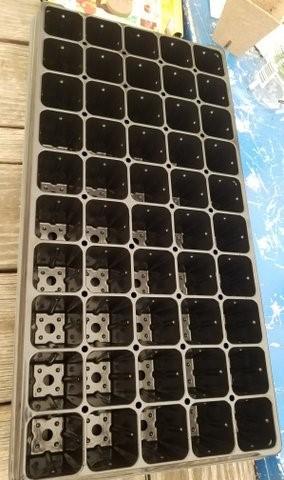 To grow seeds inside your home, you can use empty yogurt cups, To grow seeds inside your home, you can use empty yogurt cups,  party cups, tomatoe sauce
cans (but be careful of heavy metals), trays from garden centers, etc. Fill up the holes half way. party cups, tomatoe sauce
cans (but be careful of heavy metals), trays from garden centers, etc. Fill up the holes half way.
With
biodegradable cups keep plants watered while they wait to be planted.
Don't let them dry out.
For best results, drench the pots thoroughly just before planting.
Then  let them drain for a few minutes before putting them into the ground. The pots turn a dark brown when they are wet. let them drain for a few minutes before putting them into the ground. The pots turn a dark brown when they are wet.
Remove the label from the pot.
Cutting it with scissors is the easiest way. Peel off the bottom of the pot before placing the plant in its hole. This exposes the roots to ensure that they make direct contact with the soil. If the pot falls away from the root ball, this will not affect the plant.
You can compost any pieces of the pot or turn them into the ground, where they will break down, adding a little organic matter to the soil.
Bury the pot so the top of the root ball is even with the ground and the rim is no longer visible. If the pot dries out, it can rob moisture from the roots. Exceptions to this depth are tomatoes and cabbages, which are planted deeper.
 need to receive at least 6 hours of sunlight daily.
Most windows don't provide enough light. Large, south-facing ones might. If you start to see legginess (elongated (long and thin) stems between each set of leaves), that's a sign they're not getting enough light.
In that case, use cool white fluorescents with the most lumens you can find at the hardware store. Hang the lights an inch above the seedlings' leaves and raise in small increments as they grow.
You'll want to make sure you purchase lights that will illuminate your entire plantings area. You may need more than one bulb or light source to fully cover your growing area.
Different types of plants need different amounts of light. As a general rule of thumb, most vegetables and flowering plants need 12 to 16 hours of light per day, with flowering plants at the top end of that range.
Plan on giving most plants at least 8 hours of darkness per day.
Check your seed packaging or plant tags, or ask at the nursery for specific suggestions. And make sure you turn your grow lights off every once in a while. No one likes to work 24 hours a day - even plants!
Two Rules To Go By
- Don't plant the seeds too deep. Deep enough is twice as deep as the seed is big.
- Don't let the seeds dry out. After germination do let the top of the soil dry out, then let the dryness go progressively deeper as the seedlings get taller.
Planting Procedures

1. Fill containers with slightly moistened seed starting mix. If you put seeds in a regular container, you can use potting soil, then put seed starter mix on top.
2. Plant seeds twice as deep as the seed is big. This means some seeds will be practically sitting on top of the seed starting mix with only a light dusting of mix sifted on top of them.
3. Label them. Do this immediately after sowing each type of seed or you will get them mixed up.
You also need to buy labels, markers, wax  pencils or china markers from Office Depot (red, blue, black and other colors).
Some people use popsicle sticks to label seeds. pencils or china markers from Office Depot (red, blue, black and other colors).
Some people use popsicle sticks to label seeds.
4. Bottom water if using trays until all seed starting mix is wet. If this doesn't happen after 24 hours, mist the top of the seed starting mix with your spray bottle until saturated or use your watering can.
5. Keep warm and well-watered and wait.
6. When germination has begun, place under lights if they
 aren't there already.
7. Once seedlings have their first set of true leaves, let top of soil dry out, but only the top. You can begin watering with fertilizer but only use a half-strength solution of fish emulsion and seaweed once a week.
8. Raise lights as needed, but only to one inch away from top of seedlings.
Repotting
- If starting seedlings individually, wait until they are well-rooted in their current pots, then lift the root ball out with a fork and pot up into containers about ¼ bigger than their current container, watering in with seaweed fertilizer.
- If starting seedlings in a communal pot, wait until the seedlings have at least one set of true leaves, lightly grasp by a leaf and lightly pull while pricking under the roots with a pointed object (small fork, tweezers, point of a knife, etc.). Transplant into an appropriately sized pot (small is better), and water in with half-strength seaweed fertilizer. When well-rooted, pot up again according to the instructions above for individually grown seedlings.
Fertilizing Seedlings
 Until the seedlings are a good size (a few inches tall and a few weeks old), only feed with
half-strength fertilizer to avoid burning the seedlings.
Try not to leave fertilizer in sun. Test the fertilizer on a couple of plants to see how they do in two days.
Lady Bug is better than Fish 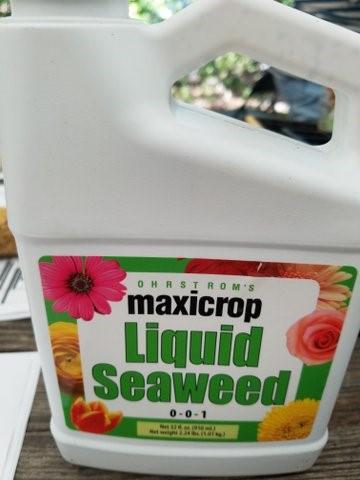 Emulsion because it already has seaweed in it. Emulsion because it already has seaweed in it.
Buy extra seaweed, liquid seaweed.
You can mix Fish Emulsion with Liquid Seaweed. Use half strength until plants gets 3 inches tall. When they get 3 inches, don't let seeds dry out. They start getting diseases at this stage. When you plant seedlings in the ground, use seaweed fertilizer (follow directions on label).
Watering Seeds
Water as soon as you plant seeds. Don't use fertilizer to start.
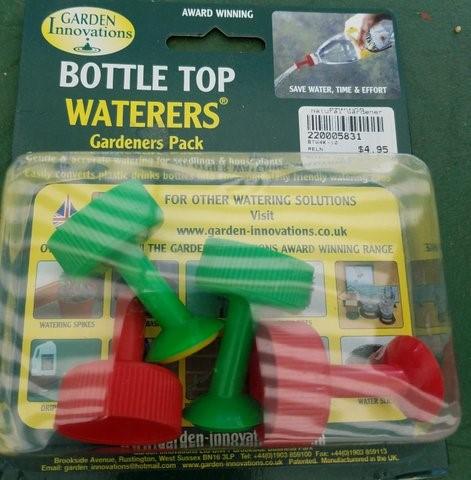
 Buy small watering cans for trays and other containers and buy bottle tops for bottled water, Buy small watering cans for trays and other containers and buy bottle tops for bottled water,  which you can also use for fertilizing. Buy handy spray bottles also. which you can also use for fertilizing. Buy handy spray bottles also.
Hardening Off
Gradually get the seedlings use to
outdoor conditions. This
 takes a week or so.
1. Put outside in morning sun for a couple of hours every day, gradually leaving them out longer each day, until they can stay out all day and night.
2.
Putting seedlings  outside in morning sun is always better than fake lights. outside in morning sun is always better than fake lights. If you can't bring them in and out every so often, build a
cold frame or
 use a
floating row cover. Floating row covers allows the sun to come in. You can use
light weight or
heavy row covers.
Put the seedlings in the cold frame or under the row cover in the morning, then bring them in at night. Over the course of the week, gradually lift the row cover or cold frame lid a few inches higher each day until they're practically uncovered.
The seedlings will get use to different breezes, winds, etc.
Other Things To Remember:
-
Remember that if you start early, you will get a bigger harvest sooner.
-
A greenhouse is like a hospital. It has pests and diseases on transplants. It's a risk of gardening.
-
You can't store potting soil in sheds or garages. It's too hot! Store inside house or other air conditioned areas. Add  water if it is dry. It should be damp when you use it. water if it is dry. It should be damp when you use it.
-
The enemy of seeds are "moisture" and "temperature." Leave extra seeds in seed packets after use and close with paperclip. Place packets in
canning jar with rice at the bottom, then store in freezer/refrigerator for
long term seed storage. Label the contents clearly and date it as well.
- Seeds can be started in or outdoors. Basil don't like to be
 inside. inside.
- Put 1 label for every kind of seeds. Cauliflower and cabbage look identical as seedlings so you need to label. Put label in then plant or plant them then add label.
- Plant tomatoe seeds around X-mas inside.
 Plant peppers New Years day. Beans and squash is "stupid easy" so you can plant in the ground. Spinach won't start when it is 80 degrees. Plant peppers New Years day. Beans and squash is "stupid easy" so you can plant in the ground. Spinach won't start when it is 80 degrees.
- When you plant outside, you can put 2 or 3 seedlings in same spot and remove the ones that are not doing well.
Cathy Harris, Speaker, Author, Coach
Angels Press, CEO, President, Publisher
National Non-GMO Health Movement
Austin, TX 78760
My First Garden Journey:
How I Built A Raised
Bed Garden
40 Days
Update on
"My Raised
Bed Garden Journey"
Aug. 10, 2017
50 Days
Fifty (50) days is about the time to start harvesting some of your crops, especially if you planted fast-growing vegetables. I discussed that topic in my book
"Overcoming Food Deserts in Your Community: How To Start a Home, School, or Community Garden, Food Co-op or Food Coalition" - available as an e-book or paperback, so pick up a copy today
(click here).
Vegetables which grows
in 40 days or less include loose-leaf lettuce, mustard and spinach, as well as chives and radishes.
Vegetables ready in
60 days or less
include zucchini, summer squash, cucumbers, broccoli, peas, bush beans, kale, early cabbage, cauliflower, beets, turnips, kohlrabi, scallions, collards, kale, and Swiss chard.
This is a reminder of all the crops I planted in my
FIRST  raised bed garden raised bed garden on
June 14, 2017. So today I will be giving you a 50 day report back on the progress of each of the plants.
We planted
peppers, cucumbers, spinach, Swiss chard, honey dew melons, cataloupes, watermelons, tomatoes, a
lemon and
tangerine tree in a container.
 The
tangerine tree did not make it. It's all my fault because I repotted it to a pot without a drainage hole and when I went to repot it again to a pot with a drainage hole, I did not handle the repotting with kids gloves and ended up violating the roots. Plus I needed to add more potting mix to the new pot, which I did not do, so this will be a lesson learned.
Also my mate had been going behind me giving my two trees in containers water, so it could have also died from overwatering. Since he felt the need to do this, I just put the care of the lemon tree in his hands, after all the raised bed was all mine, even though he was in charge of watering it.
Tomatoe Plants
 Well the 7 tomatoe plants that belong to my mate because I don't eat tomatoes, because of my blood type diet, did not fare well. I don't have to worry about the tomatoe plants blocking the sunlight off my crops because the crops are so big now and the tomatoe plant, which initially had the catepillars on it, died.
I believe the tomatoe plants died because of the high heat (over 100 degrees for 30
 days in Austin, TX) and my mate refused to put a
shade cloth on the tomatoe plants as suggested by the instructor in my gardening class.
I believe another reason the tomatoe plants did not make it is because my mate used another soil on his cinder block garden and the big pot, which was different than what I used in the raised bed garden. So next time we will use the same dirt, Thunder Dirt, from GEO growers.
None of the 7 tomatoe plants containing 3 different types of tomatoes, did very well, but the cherry tomatoe
 plant, which is supposed to grow well in the heat of summer is hanging on by a thread and still have some green tomatoes. In case the branch dies, we went ahead and tasted the tomatoes and they were good. I
t was actually the
first food we tasted
from our crops.
There were several more red
 cherry tomatoes, however, I believe the birds ate them. Even though we have the bird scare tape, my mate hasn't put it up yet.
 Next year we will plant the tomatoe plants in
different locations also as suggested by the class instructor in order to keep down the chances of getting diseases on crops. And don't forget that most people get into gardening anyway in the first place because they look forward
 to growing tomatoes. to growing tomatoes.
A healthy cherry tomatoe (which is the size of a cherry) plant would have looked like this picture. I also believe we planted the tomatoe plants too late in the season to gather a full bushel like we had hoped so we will plant tomatoes much earlier next year.
Honeydew Melons
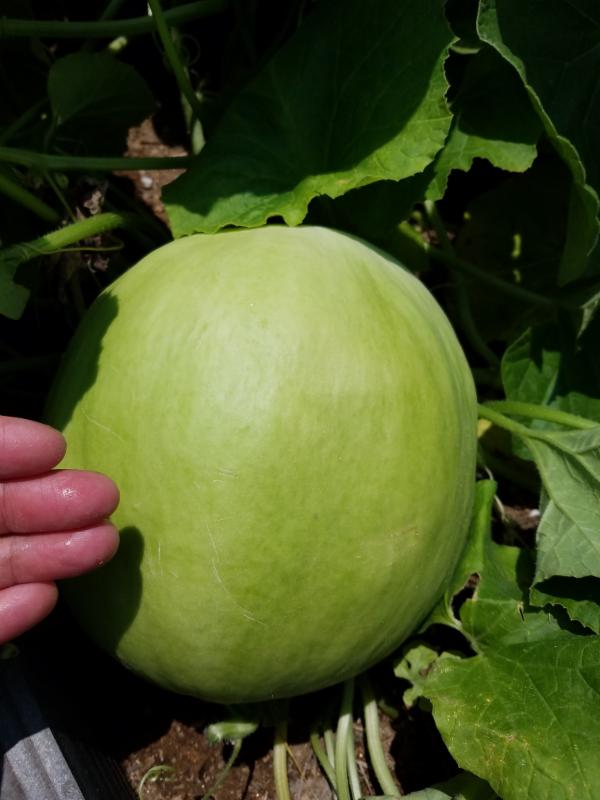 The honey dew melons are
 coming along after
50 days. So far there is a big one about the size of a cantaloupe that we should be able to put on our plates in a couple of weeks. It looks awesome and both my mate and I had this warm feeling that came upon us when we first found it hidden under all the vines. Wow what a thrill to see your hard work and have the pleasure of growing your own foods. I can't desc
ribe it! You actually have to do it yourself to get this feeling.
Cantaloupes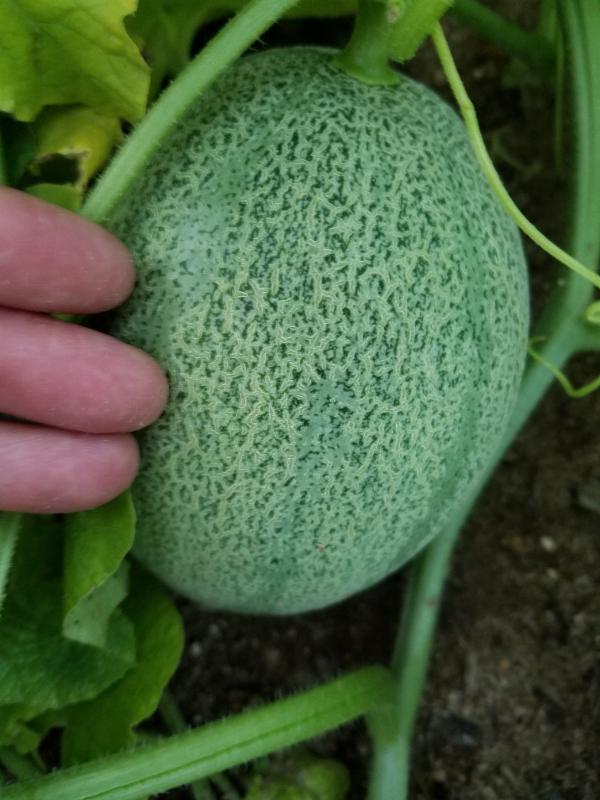
The cantaloupes are really looking awesome after 50 days. They are slightly bigger than a baseball and is still green. I love cantaloupes, but I will probably be traveling when they develop fully so I have to get my mate to describe the taste to me and hopefully we can freeze many of the vegetables until I return back home.
Watermelons
 Our watermelons are about the size
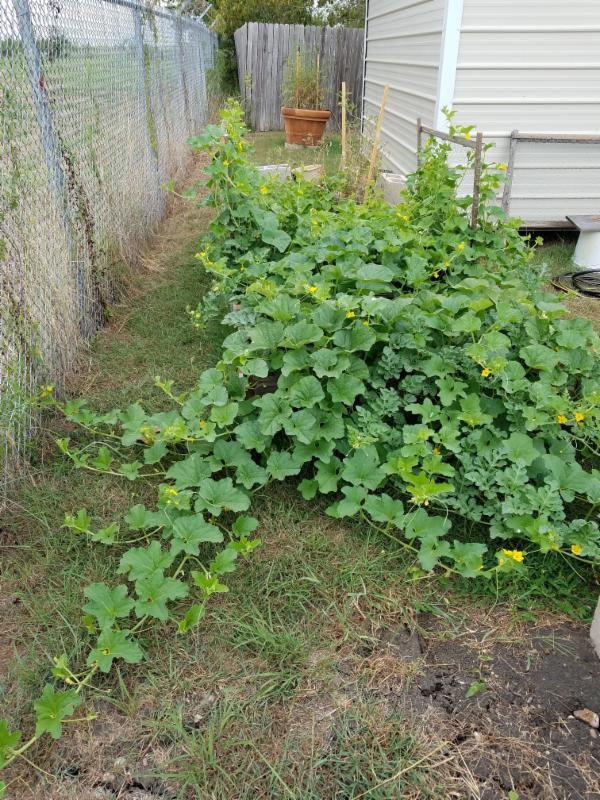 of a baseball after
50 days and we have several ones, even though I planted 7 seeds total, so they are looking good and coming along.
And as you can see the watermelon, cataloupe and honey dew melon vines are everywhere. I planted the watermelons at the very end of the raised bed garden, but now the branches have branched off out of the garden, so we are seeking ways to control the growth of the branches. Of course watermelons are too big to go on trellis like tomatoes.
Cucumbers
After 50 days the cucumbers are coming up, but they are
 very small. We could barely see them because while we were out of town for one week, the watermelon, cataloupe and honeydew melon vines took over the raised bed garden.
We would have been in a better position to guide the vines up the fence surrounding it, or away from the other foods had we been here to monitor it. It just goes to show you how fast food grows, once you give it the nutrients it need in using good soil and fertilizers.
Swiss Chard
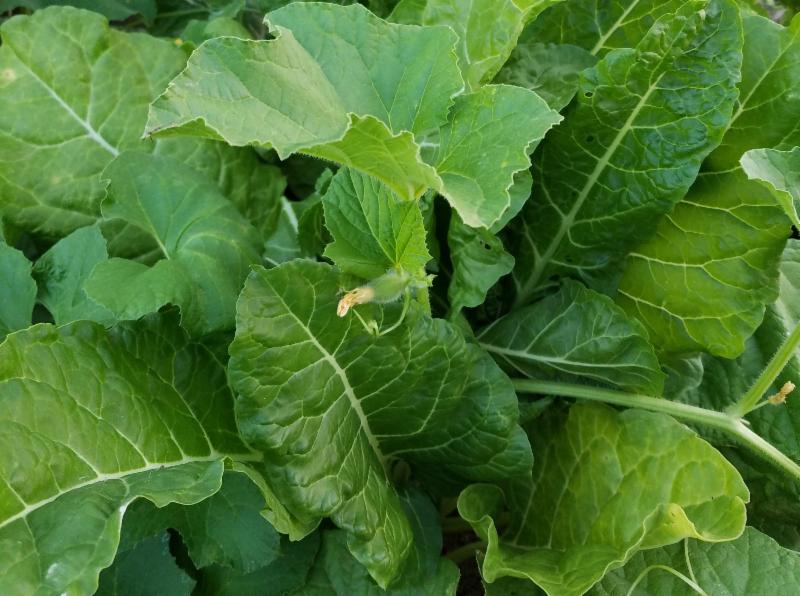 I planted Swiss Chard in two rows about 4 inches a part. Like most of the foods, despite what the seed packets say about the spacing, I found out that many of the foods should have been spaced further apart.
I could barely see the Swiss
 Chard, but it is coming up nicely and looks like it is ready to pick and steam and eat. Supposedly, this is one of the foods you can cut off 2 inches from the root with a knife or sharp pair of garden scissors, and it should grow back. We will see!
Watering/Drip System
We had to go out of town for 7 days and visit family in 5 different states and this is when the watermelon, honeydew melon and cantaloupe vines took over the raised bed garden, so next time I hope to grow these 3 foods by themselves in one raised bed garden.
I was really worried that I would come back and all my crops would be dead, especially after 100 degree weather for over 30 days here in Austin. W
e did not set up a drip system
 like most home owners or gardeners. Instead we (my mate) rigged a
drip system using a
sprinkler system (Orbit Hose Faucet Timer from HomeDepot.com) that was on a timer and it worked great. Twice a day for 20 minutes, the raised bed
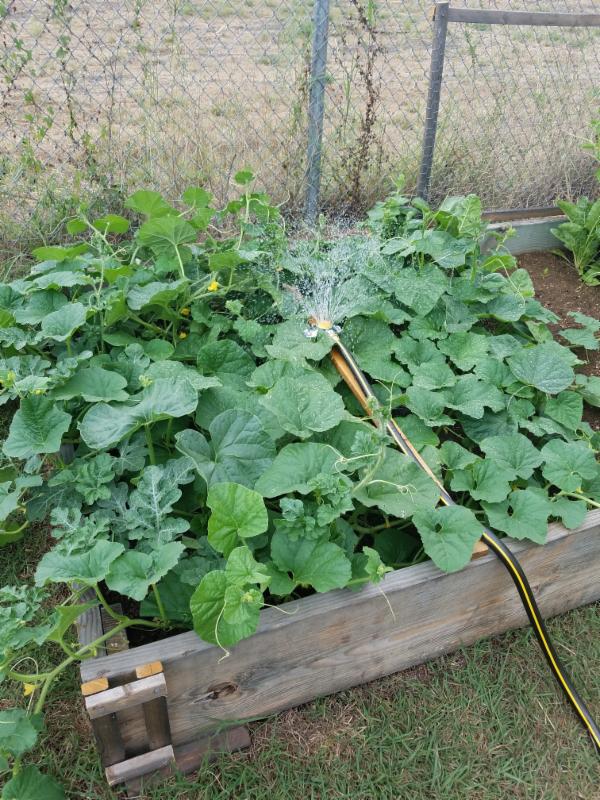 garden, my mate's smaller cinder block garden and a big pot of tomatoes, received all the watering it needed. Now when we get ready to travel in the future, this definitely won't be something we will have to worry about. My mate did an awesome job!
He has now left everything hooked up so to water everything, all he has to do is just turn on the water. Again, this was a great idea, however, next time it might even be a better idea to plant a drip system in the soil, before planting the garden so we will investigate this idea.
The ideas of how to run our garden have been endless, intriguing and exciting at the same time.
I am continuing to monitor youtube.com to help you find great gardening videos to post at my gardening club
"Cathy Harris Garden Club"
(
www.CathyHarrisGardenClub.com), in order
to help you get started gardening.
On that blog, you will also find all the articles I am writing. My upcoming book that I plan on writing in a couple of years is actually writing itself with all the blog posts. I will simply take the blog posts and put them into another non-fiction book. For instance something similar to "My First Gardening Journey: How To Grow Your Own Foods and Live an Energetic Life." This is a great way for anyone to write a book by starting with blog posts.
10 Steps To Start Growing
Your Own Foods
How To Use Pots and Containers
To Grow Foods
What You Need To Know About
Roadside Vendors Today
|
|
Message from "The Essential Women's Movement for African American Women"
|
|
|
The Essential Women's Movement for African American Women
|
|
|
|
Mastermind Meeting - How To Grow Your Own Foods -
July 18, 2017
|
Join our MONTHLY
Masterminds,
Think Tanks,
and Classrooms
Join us
every 3rd Tuesday,
Aug. 15, 2017, 7:00-8:30 p.m. (CST), for monthly teleconference calls. Call (712) 770-4715, Pin Code: 243460. New playback number is (712) 770-4772.
3 Phases of New Food Movement
"Virtual Organic Garden Clubs"
Who Are "The New Black Farmers"?
I have coined the phrase "The New Black Farmers." For clarification purposes, when I mention "The New Black Farmers" -- these are black families who are now growing their own foods. They might have started out on a small scale or only growing foods for their immediate family members, but they clearly see opportunities to increase the amount of foods they are growing to offer to neighborhood grocery stores, restaurants, catering companies, farmer's markets, roadside stands, and in GOOD FOOD BOXES in food co-ops or food coalitions, etc.
They are visionaries so they see opportunities to set up job's programs and business opportunities, especially for former prisoners and our young sons, around growing our own foods. They are walking away from abusive and unfriendly workplaces and instead starting their own farms or homesteads. Failure is simply not an option for them. These are "The New Black Farmers" of today. Welcome aboard!


Cathy Harris is a Veteran, U.S. Army, and former U.S. Customs Inspector/Officer who worked  over 25 years in a male-dominated industry. over 25 years in a male-dominated industry.
In order to survive in her industry, she confronted her male co-workers including supervisors and managers and filed 10 EEOC.gov workplace complaints, a Sexual Harassment Complaint and a Whistleblower complaint.
She filed 4 complaints her ownself, without the services of a lawyer, in federal district court in Atlanta. Not only did she prevail in a lawsuit against her job, but her story, "TheCathyHarrisStory.com" was used to change Whistleblower laws in this country.
In 1998, Cathy Harris became a World-Renowned Whistleblower, "The Cathy Harris Story", and women's rights advocate when she exposed to Congress, Senate and the media, that her co-workers at the U.S. Customs Service (now called Customs and Border Protection) were targeting African American women international travelers for abusive pat-downs, humiliating strip searches and prolonged detentions, which lasted for up to 4 days in order to make more overtime money, even when it was obvious that some of these women were pregnant, even up to 8 months pregnant.
After her revelations, changes were made to protect black women international travelers. She was responsible for the introduction of the "Civil Rights for International Traveler's Act"
introduced by Congressman John Lewis (D-GA) from Georgia and the "Reasonable Search Standards Act" that was introduced by Senator Richard Durbin (D-IL) from Chicago.
She has sat on panel discussions with FDA, USDA, EPA, FBI, CIA, Police Department, Justice Department, Meat Industry, Peanut Butter, and other Industry Whistleblowers and is the author of 24 non-fiction books, including 5 books on health and 2 business books.
As an Empowerment and Motivational Speaker, Non-GMO Health and Wellness Expert, Self-Publishing and Business Coach, she has conducted extensive research on the topics of her books including family and community empowerment, health, youth and adult entrepreneurship, writing/publishing, workplace discrimination (sexism, sexual harassment, sex and race discrimination), whistleblowing, law enforcement, government, domestic and international traveling, politics, media, beauty/self-esteem, car buying and selling for women, aging/retirement - just to name a few.
She provides seminars, workshops, webinars and consultations through her speaking and training platforms at
http://www.cathyharrisinternational.com and can be reach through her empowerment company, Angels Press, CEO, President, Publisher, P.O. Box 19282, Austin, TX 78760, Phone: (512) 909-7365, Website:
Yours truly,
Cathy Harris, Speaker, Author, Coach
Angels Press, CEO, President, Publisher
National Non-GMO Health Movement
P.O. Box 19282
Austin, TX 78760
(512) 909-7365
(Seminars, Workshops, Coaching)
(Webinars)
(Empowerment & Publishing Company)
(Advice Columnist)
(The Cathy Harris Story)
|
|
Cathy Harris New Products
Downloadable Webinars - $4.99
Downloadable Audios - $2.99
E-Articles - $4.99
Coming Soon as PDFs, Audios or Webinars
- 7 Steps To A Beautiful Smile
- 7 Steps To Beautiful Skin
- How Much Water Should You Drink Daily and What's the Best Type of Water to Drink?
- What Are The Best Vitamin and Mineral Supplements To Take?
- Why You Need To Exercise
- How To Establish Good Sleeping Habits
- How To Turn Your Brain Back On and Stop Depression
- What You Need To Know About Your Thyroid
- What You Need To Know About Yeast
- Why Women Need to Lose Weight or Keep a 35 Inch or Smaller Waistline
- Why Chicken is Bad for You and The Best Type of Meat to Eat
- Why Juicing Foods Is Good for You
- How To Create Your Own Speaker's Tour
- How To Create Your Own Public Relations (PR)/Marketing Company
- How To Stop Racial Profiling and Police Brutality and much, much, more...
|
|
Are You Ready to Make
Your Dream Come True of
Writing A Book?
How To Write A Book: The Complete Guide
To Writing and Publishing Your Own
Paperback and E-book
Available as E-book, Paperback & Audiobook
|
|
|
AUDIOBOOK
HOW TO WRITE A BOOK by CathyHarrisInternational.com
|
Audiobook Available at:
Itunes.com
Available as E-book and Paperback
|
Cathy Harris List of Books
Cathy Harris List of Books
Books can be read by
12 year olds and above...
|
|
Find Cathy Harris on Social Media
Join Cathy's Groups on Facebook.com
Join Cathy's Meetup.com Groups
All Books are Available at AngelsPress.com
Brought To You By
AngelsPress.com
Cathy Harris
Empowerment and Motivational Speaker,
Non-GMO Health and Wellness Expert, Advice Columnist at DearCathy.com, Self-Publishing and Business Coach and author of 24 non-fiction books at
Cathy Harris, Speaker, Author, Coach
Angels Press, CEO, President, Publisher
P.O. Box 19282
Austin, TX 78760
(512) 909-7365
(Seminars, Workshops, Coaching)
(Empowerment & Publishing Company)
(Advice Columnist)
(The Cathy Harris Story)
"We Can Sit Back and Watch As the World Goes By
or We Can Find Opportunities To Make It Better."
....Cathy Harris
Send This E-newsletter to
Everyone You Know
|
|
|
|
|
| |
|